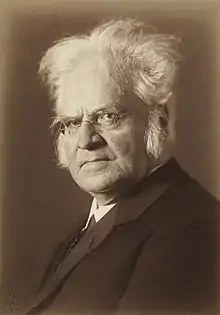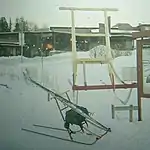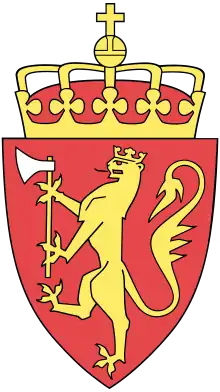Tynset
Tynset is a municipality in Innlandet county, Norway. It is part of the traditional region of Østerdalen. The administrative centre of the municipality is the village of Tynset.
Tynset kommune | |
|---|---|
 Coat of arms  Innlandet within Norway | |
 Tynset within Innlandet | |
| Coordinates: 62°16′31″N 10°49′57″E | |
| Country | Norway |
| County | Innlandet |
| District | Østerdalen |
| Administrative centre | Tynset |
| Government | |
| • Mayor (2015) | Merete Myhre Moen (Sp) |
| Area | |
| • Total | 1,879 km2 (725 sq mi) |
| • Land | 1,822 km2 (703 sq mi) |
| Area rank | 34 in Norway |
| Population (2004) | |
| • Total | 5,463 |
| • Rank | 180 in Norway |
| • Density | 3/km2 (8/sq mi) |
| • Change (10 years) | 1.1% |
| Demonym(s) | Tynseting[1] |
| Time zone | UTC+01:00 (CET) |
| • Summer (DST) | UTC+02:00 (CEST) |
| ISO 3166 code | NO-3427 |
| Official language form | Neutral[2] |
| Website | www |
General information
Name
The municipality (originally the parish) is named after the old Tynset farm (Old Norse: Tunnusetr), since the first church was built here. The first element is the genitive case of the river name Tunna (now Tonna); the last element derives from setr which means "homestead" or "farm". (The meaning of the river name is unknown.)[3] Prior to 1918, the name was written "Tønset" (pronounced Teunset, the diphthong equivalent to that in the French: bleu).
Coat-of-arms
The coat-of-arms is from modern times. They were granted on 18 October 1985. The arms show the silver/gray head of a moose on a blue background. It was chosen to symbolize the abundance of moose in the area.[4]
(See also the coat-of-arms for Aremark, Namsos, Namsskogan and Ringsaker.)
| Ancestry | Number |
|---|---|
| 125 | |
| 91 | |
| 77 | |
| 45 | |
| 37 | |
| 36 | |
| 34 |
History
The parish of Tønsæt was established as a municipality on 1 January 1838 (see formannskapsdistrikt). Although the municipality of Alvdal was originally a part of Tynset, it became a separate municipality in 1864. The former municipality of Kvikne was merged with Tynset in 1966.
Geography

Tynset is the municipal centre of the Nord-Østerdalen area of Innlandet county. Well positioned in the central area of mainland Norway, Tynset lies in the upper quadrant of Norway's longest valley, Østerdalen /ˈʌstərdɑːlən/ at approximately 480 metres (1,574.8 ft) above sea level. To the northeast lies the municipality of Tolga; south of Tynset are Rendalen and Alvdal; and to the west is Folldal. In the neighboring county of Sør-Trøndelag, Tynset is bordered to the north by the municipalities of Rennebu and Midtre Gauldal, and to the west by Oppdal.
Outdoor life
Tynset is known for its vast areas of forest and mountain, which are ideal for skiing, walking, cycling, hunting, and fishing. In many areas are signposted paths and ski tracks are ploughed in winter.
Wildlife
Tynset has many wildlife areas, which are regarded as national treasures; the geological formation at Ripan and Gammeldalen are extremely interesting: at Ripan is a lake formed by glaciation during the last Ice Age and at Gammeldalen are found some beautifully formed corries from the same period.
Seters
Tynset can be proud of being one of those municipalities that has many of its mountain farms (seter) still in use, and it is possible to visit such farms when out hiking, which proves to be a valuable experience both for children and adults. Tynset municipality also rents chalets, which used to belong to mountain farms.
Climate
Sheltered by mountains, the average annual precipitation in Tynset is only 400 millimetres (16 in) and the mean annual temperature is 0 °C (32 °F). Winters are cold but stable. The temperature in January averages −13 °C (9 °F) and the temperature falls below freezing from November until about mid-April. In July, the 24-hr average temperature is about 12 °C (54 °F). July is also generally the wettest month, with an average precipitation of about 70 millimetres (2.8 in). This corresponds to a continental subarctic climate.[6]
| Climate data for Tynset | |||||||||||||
|---|---|---|---|---|---|---|---|---|---|---|---|---|---|
| Month | Jan | Feb | Mar | Apr | May | Jun | Jul | Aug | Sep | Oct | Nov | Dec | Year |
| Average high °C (°F) | −9 (16) |
−4 (24) |
2 (35) |
7 (44) |
12 (53) |
16 (61) |
17 (63) |
17 (62) |
12 (53) |
6 (43) |
−2 (29) |
−5 (23) |
6 (42) |
| Average low °C (°F) | −18 (−1) |
−15 (5) |
−12 (10) |
−3 (26) |
0 (32) |
5 (41) |
6 (43) |
6 (43) |
2 (36) |
−2 (29) |
−8 (18) |
−14 (7) |
−4 (24) |
| Average precipitation mm (inches) | 18 (0.7) |
15 (0.6) |
7.6 (0.3) |
10 (0.4) |
38 (1.5) |
84 (3.3) |
86 (3.4) |
81 (3.2) |
28 (1.1) |
18 (0.7) |
13 (0.5) |
15 (0.6) |
410 (16.1) |
| Source: Weatherbase [7] | |||||||||||||
Transportation

The village can be reached easily by railroad, road, and air. The trunk road Rv3, the shortest route between Oslo and Trondheim, runs through Tynset, and the Rondevegen connects Tynset to Lillehammer (south), Røros (north-east) and continues further into Sweden. Rv30, which passes through Rendalen, also continues into Sweden. The Rørosbanen railway line connects Tynset with the major cities of Oslo and Trondheim. Røros Airport, 55 kilometres (34.2 mi) away, is part of the national network. Tynset also hosts an aerodrome that is used by smaller aircraft.
Economy
With a population of 5,400; Tynset is the municipal centre of the Nord-Østerdalen region. Although it is a modern business and shopping centre with a wide variety of commercial activities, agriculture, and forestry are still the traditional ways of making a living. However, municipal administration and service industries, such as the computer industry, law, finance, and construction are beginning to play an increasing role. Tynset has most of the functions of a regional centre because of its schools and hospital, and many of the region's intermunicipal services have naturally been positioned in Tynset: The Family Centre, Centre for School Psychology, and others. Tynset also used to produce the latex Troll souvenirs, but production has now moved abroad.
Culture
Tynset has a rich cultural life with a huge range of organisations in sports, music, drama, the arts, and youth work.
Kulturhuset
When the Centre for The Arts (kulturhuset) was opened in 1988, Tynset entered a new era in which the centre has become a living, breathing cultural home for the population of Tynset and Nord-Østerdalen. The centre houses concerts, plays, a cinema, library, art exhibitions, rehearsals, reunions, conferences, and festivals. The Kulturhuset also hosts a café where people meet informally.
Tynsethallene
Tynset's first sports hall (Tynsethallen) was built in 1986. A second sports hall (Holmenhallen) was opened ten years later. A swimming pool and smaller Gymnastics Hall in the building connects them to form a complete set of sports' facilities that few municipalities of Tynset's size can equal.
Savalen
Savalen is known internationally for its speed skating ice rink, where many national and international records have been achieved. Now, Savalen has also developed a football pitch, an arena for Nordic skiing and biathlon, roller skiing track, an alpine area, and 90 kilometres (55.9 mi) of cross-country skiing tracks. Savalen has become a place that is specially designed for the handicapped, which includes wheelchair paths and a specially equipped fishing pier. Savalen now suits people of different ages who like different outdoor pursuits. With its various types of accommodation Savalen has become renowned as a holiday area.
Notable people

- Anders Rambech (1767 in Kvikne – 1836) a district stipendiary magistrate and politician
- Bjørnstjerne Bjørnson (1832 in Kvikne – 1910) a poet and writer who received the 1903 Nobel Prize in Literature [8]
- Odd Aukrust (1915 in Tynset – 2008) a Norwegian economist
- Olav Gjærevoll (1916 Tynset – 1994) a botanist, academic and politician
- Fridtjof Frank Gundersen (1934 in Tynset – 2011) a professor of jurisprudence and politician
- Gert Nygårdshaug (born 1946 at Tynset) an author of poems, children's books and crime novels
- Bersvend Salbu (born 1968) a Norwegian farmer, politician and Mayor of Tynset 2007-2015
- Ellen Brekken (born 1985 in Tynset) jazz musician, plays upright bass, bass guitar and the tuba
Sport
- Willy Olsen (born 1950 in Tynset) a retired speed skater, competed at the 1972 Winter Olympics
- Solrun Flatås (born 1967 in Tynset) a cyclist, competed at the 2000 Summer Olympics
- Tor Halvor Bjørnstad (born 1978) a retired cross-country skier, biathlete and winter triathlete; lives in Tynset
- Kai Olav Ryen (born 1978 in Tynset) a footballer with 223 club caps
Attractions
The following are some attractions in the area. The distance from the municipal center is shown.
- Kvikne Mines in Odden. The remains of mining operations begun in 1632. (60 min.)


- Kvikne Church. A cruciform timber church built in 1652, with a richly decorated interior. The altar is an example of one of Norway's finest Renaissance altarpieces and the church is adorned with staves (planks) on which one can see Viking graffiti, an 11th-century crucifix and other artifacts from the Viking period. (45 min.)
- Vollan Farm and Chapel. The farm was originally built in the mining period, the earliest part of which dates from the 17th century. This is one of the few farms in the country with its own private chapel. (45 min.)
- Vollandagan: An annual festival connected with the traditional life of Vollan.
- Bjørgan parsonage, Kvikne. The birthplace of the author Bjørnstjerne Bjørnson. (50 min.)
- Soapstone quarry, Kvikneskogen, dates from 400–600 BC. (30 min. + 45 min. on foot).
- Røstvangen Mines. The remains of a mining community from the beginning of the 20th century. It survived for only 17 years and was ruined by the greatest bankruptcy of the period. (25 min. + 15 min. on foot).
- Eidsfossen Power Station, a decommissioned hydroelectric plant 5 km south of Yset that formerly powered the Røstvangen Mines.
- Tynset Bygdemuseum. Tynset's village museum is 1 kilometer from the town centre and contains exemplar housing from early times to the present.
- Tynset Church. An octagonal church that was built in 1795 by the architect of a larger example in Røros. The church displays a fine, gilded pulpit over the altar, which is peculiar to this area of Norway. A smaller copy of this church was built in 1825 at Bardu in the northern county of Troms by the contractor (and native of Tynset) Ola Olsen Lundberg and is accurate many details.
- Ramsmoen museumssenter: Exhibitions throughout the year, located in the centre of Tynset.
- Garborgdagan. An annual festival built around the work of the authors Hulda Garborg and Arne Garborg. Held in Tynset kulturhus and at Kolbotn, Garborg's home for many years.
- Tynsetutstillinga. An annual exhibition held in Galleri Elgen in Tynset kulturhus, featuring well-known Norwegian artists.
- Tylldalen church. Built in 1736, the rich wall painting survived the puritan period by being painted over, thus preserving its original colours. A fine altar dominates the sanctuary and fine ceiling paintings, displaying the Swedish royal arms, make this a fine example of Norwegian late-baroque architecture.
- Tylldalen bygdetun. Tylldalen's village museum (20 min.) A biennial play for St. Olav's Day is Norway's second oldest historical outdoor play.
References
- "Navn på steder og personer: Innbyggjarnamn" (in Norwegian). Språkrådet.
- "Forskrift om målvedtak i kommunar og fylkeskommunar" (in Norwegian). Lovdata.no.
- Rygh, Oluf (1900). Norske gaardnavne: Hedmarkens amt (in Norwegian) (3 ed.). Kristiania, Norge: W. C. Fabritius & sønners bogtrikkeri. p. 397.
- Norske Kommunevåpen (1990). "Nye kommunevåbener i Norden". Retrieved 2008-12-30.
- "Immigrants and Norwegian-born to immigrant parents, by immigration category, country background and percentages of the population". ssb.no. Archived from the original on 2 July 2015. Retrieved 29 June 2015.
- "Climate" (in Norwegian). Norges Meteorologiske Institutt.
- "Weatherbase: Historical Weather for Tynset, Norway". Weatherbase. 2011. Retrieved on November 24, 2011.
- Gosse, Edmund William (1911). . In Chisholm, Hugh (ed.). Encyclopædia Britannica. 04 (11th ed.). Cambridge University Press. p. 17.
External links
| Wikimedia Commons has media related to Tynset. |
| Look up Tynset in Wiktionary, the free dictionary. |
- Municipal fact sheet from Statistics Norway
- Tynset website (in Norwegian)
- Tynset church: includes information on the church and a series of virtual tours



